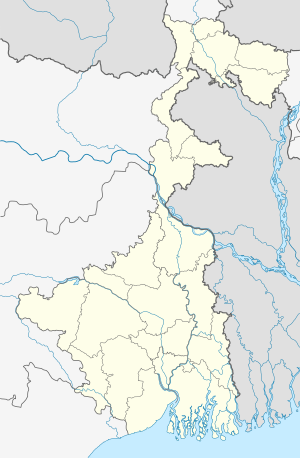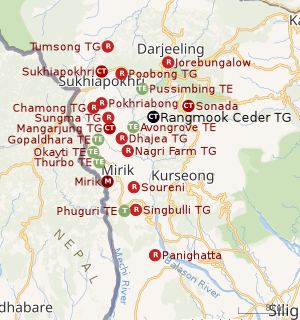Rongmook Ceder Tea Garden
Rongmook Ceder Tea Garden is a census town in the Jorebunglow Sukhiapokhri CD block in the Darjeeling Sadar subdivision of the Darjeeling district in the state of West Bengal, India.
Rongmook Ceder Tea Garden | |
|---|---|
Census Town | |
 Rongmook Ceder Tea Garden Location in West Bengal, India  Rongmook Ceder Tea Garden Rongmook Ceder Tea Garden (India) | |
| Coordinates: 26.9498°N 88.2383°E | |
| Country | |
| State | West Bengal |
| District | Darjeeling |
| Area | |
| • Total | 7.1428 km2 (2.7579 sq mi) |
| Population (2011) | |
| • Total | 5,150 |
| • Density | 720/km2 (1,900/sq mi) |
| Time zone | UTC+5:30 (IST) |
| PIN | 734219 |
| Telephone/STD code | 0354 |
| Lok Sabha constituency | Darjeeling |
| Vidhan Sabha constituency | Kurseong |
| Website | darjeeling |
Geography
 |
| Places and tea estates in the southern portion of Darjeeling Sadar subdivision (including Jorebunglow Sukhiapokhri CD block), and Mirik Subdivision in Darjeeling district CT: census town, R: rural/ urban centre, NP: national park/ wildlife sanctuary, TE: tea estate Abbreviations used in names – TG for Tea Garden (town/village), TE for Tea Estate Owing to space constraints in the small map, the actual locations in a larger map may vary slightly |
Location
Rongmook CederTea Garden is located at 26.9498°N 88.2383°E.
Area overview
The map alongside shows a part of the southern portion of the Darjeeling Himalayan hill region in the Darjeeling district. In the Darjeeling Sadar subdivision 61.00% of the total population lives in the rural areas and 39.00% of the population lives in the urban areas. In the Mirik subdivision 80.11% of the total population lives in the rural areas and 19.89% lives in the urban areas.[1][2] There are 78 tea gardens/ estates (the figure varies slightly according to different sources), in the district, producing and largely exporting Darjeeling tea. It engages a large proportion of the population directly/ indirectly.[3]Some tea gardens were identified in the 2011 census as census towns or villages. [4]Such places are marked in the map as CT (census town) or R (rural/ urban centre). Specific tea estate pages are marked TE.
Note: The map alongside presents some of the notable locations in the subdivision. All places marked in the map are linked in the larger full screen map.
1970s and 1980s were times of trouble for the tea gardens. Most of the British owners left and went back to England. Geoffrey James Ower-Johnston, the owner of Rungmook Cedar Tea Estate, having long family links with the garden, was struggling to keep things going. Poor financial management, labour agitation and natural disasters had pushed the garden into the red. The workers were not being paid. In 1981, the state government had listed the garden as “sick” and certain legal procedures were continuing, when Geoffrey was mobbed and after some altercations, he handed over the gun he always carried and then was attacked with daggers and spears. He died and was buried in Darjeeling.[5]
Mandakini Arora
Demographics
According to the 2011 Census of India, Rongmook Ceder Tea Garden had a total population of 5,150 of which 2,528 (49%) were males and 2,622 (51%) were females. There were 423 persons in the age range of 0 to 6 years. The total number of literate people in Rongmook Ceder Tea Garden was 3,455 (67.09% of the population over 6 years).[6]
Infrastructure
According to the District Census Handbook 2011, Darjiling, Rongmook Ceder Tea Garden covered an area of 7.1428 km2. Among the civic amenities, it had 8 km of roads with open drains, the protected water supply involved overhead tank and spring. It had 1,220 domestic electric connections. Among the educational facilities it had were 7 primary schools, 1 middle school, the nearest secondary and senior secondary schools at Pacherig Bazar 8 km away. It had 1 non-formal education centre (Sarva Siksha Abhiyan). An important commodity it manufactured was tea.[7]
Rungmook Cedar Tea Estate
Rungmook tea estate and Cedar tea estate, both planted in the mid-1800s, were merged in the early 1900s.[8]
Rungmook Cedar Tea Estate was subsequently taken over by Darjeeling Oraganic Tea Estates Private Ltd., a company formed by Bansal, with the objective of reviving closed and sick tea gardens.[9]The garden is located at a height of 5,500 ft (1,700 m). A large portion of the garden is forested.[8]
DOTEPL group
The gardens of the Darjeeling Organic Tea Estates Private Ltd. are: Ambootia, Changtong, Happy Valley, Monteviot, Moondakotee, Mullootar, Nagri, Noorbong, Sepoydhurah (Chamling), Sivitar, Rangmook Ceder, Rangaroon, Pandam and Aloobari.[10]
References
- "Darjeeling". District Profile - General Information. District administration. Retrieved 21 March 2020.
- "District Statistical Handbook 2013 Darjeeling". Tables 2.2, 2.4b. Department of Planning and Statistics, Government of West Bengal. Retrieved 21 March 2020.
- "Darjeeling Tea". District administration. Retrieved 21 March 2020.
- "2011 Census – Primary Census Abstract Data Tables". West Bengal – District-wise. Registrar General and Census Commissioner, India. Retrieved 21 March 2020.
- "Geoffrey James Ower-Johnston". by Mandakini Arora. Koi-Hai. Retrieved 28 February 2020.
- "2011 Census – Primary Census Abstract Data Tables". West Bengal – District-wise. Registrar General and Census Commissioner, India. Retrieved 28 February 2020.
- "District Census Handbook Darjiling, Census of India 2011, Series 20, Part XII A" (PDF). Section II Town Directory, Pages 419-422: Statement I: Status and Growth History, Pages 423; Statement II: Physical Aspects and Location of Towns, Pages 424-425; Statement III: Civic and other Amenities, Pages 426-427; Statement IV: Medical Facilities 2009, Pages 428-430 Statement V: Educational, Recreational and Cultural Facilities, Pages 431: Statement VI:Industry and Banking. Directorate of Census Operations V, West Bengal. Retrieved 26 February 2020.
- "Rungmook". STE&R. Retrieved 28 February 2020.
- "Ambootia Tea Estate". Darjeeling Tea Boutique. Retrieved 28 February 2020.
- "The Finest Organic Teas". Our Evergrowing Family. Darjeeling Organic Tea Estates Private Ltd. Retrieved 1 February 2020.